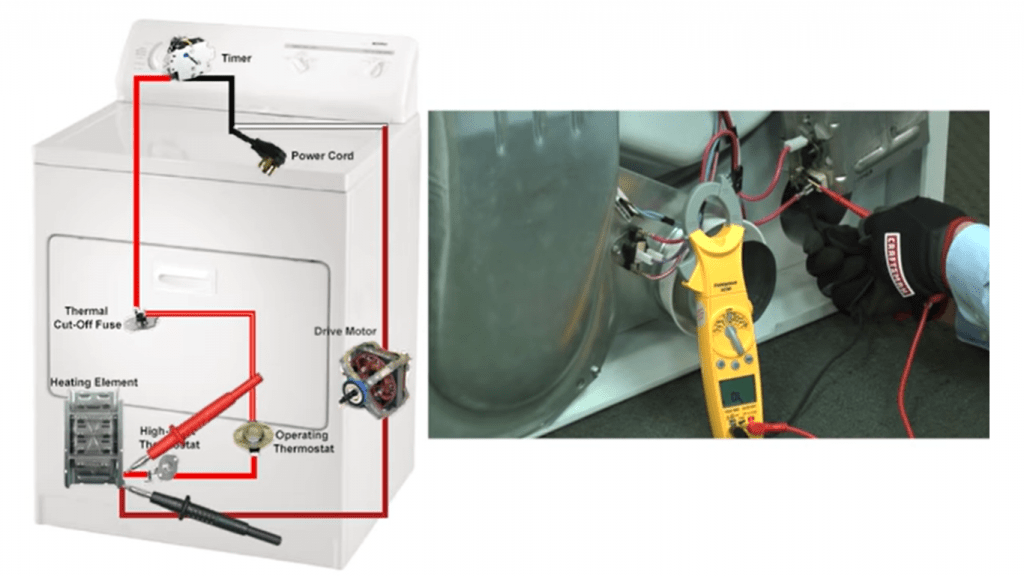One of the most common problems that homeowners face with their electric dryers is when they have a dryer not heating up. There are several possible reasons associated with failure of different components that can make the dryer to stop heating. In order to troubleshoot effectively when an electric dryer is not heating, all the different components will need to be tested.
Any of the following components can be the cause of the problem and should be included in the troubleshooting procedure:
- Power cord
- Heating element
- High-limit thermostat
- Operating thermostat
- Thermal cut-off fuse
- Timer
Check the power cord
One of the most common reasons why a dryer will not be heating is if it doesn’t get the correct amount of power. It’s easy to forget and assume nothing is wrong with the power, but that’s an important check at the beginning of your electric dryer troubleshooting process. The heating element requires 240 volts while the motor will start running even with as low as 120 volts. Do a check of the power cord to make sure it has no damage and reset the circuit breaker in your house to confirm it hasn’t tripped. You can then turn the knob to put the dryer on a timed dry for high heat cycle to see if it will heat up. If that doesn’t solve the problem, next you will need to check the components on the control circuit for continuity.
Checking for continuity
You will need a multimeter to test all the control circuit components at once. Make sure to disconnect your dryer from the power source for safety while checking for continuity. You will also need to remove the dryer’s back panel and also the back of its control panel. Check on the timer’s terminal “A” to unplug a large red wire. Then take your multimeter and set it to read ohms for measuring resistance. You will then need to measure the resistance between the large red wire unplugged from the “A” terminal on the timer and the terminal on the heating element where the large red wire connects. Your multimeter should read about 15 ohms of resistance if there is continuity for the heating element, high-limit thermostat, operating thermostat and thermal cut-off fuse.
Checking the heating element
If you detect no continuity for the control circuit, you will next need to check for the continuity of each component one at a time. Start by placing your multimeter leads on the terminals of the heating element. If there is continuity, your multimeter should also read about 15 ohms. That would indicate no problem with the heating element, so next you will need to do the same test for the high-limit thermostat.
Check the high-limit thermostat
Place your multimeter leads one for each of the terminals of the high-limit thermostat and you should read near zero ohms if there is continuity. In case there is no continuity, then it would mean that the high-limit thermostat is bad and would require replacement. If no problem, next check the operating thermostat.
Check the operating thermostat
Place one lead of the multimeter on one of the wire terminals and the other lead on the remaining wire terminal. You should also measure near zero ohms if there is continuity, but if no continuity then the operating thermostat would need to be replaced. If that goes well, next check continuity for the thermal cut off fuse
Check thermal cut-off fuse
With this you should also read near 0 ohms if it’s good and there is continuity, if not then replace the fuse. If everything is good so far, the last thing to check will be the timer.
Checking the timer
Make sure your dryer is still disconnected and turn the timer to time dry, dry heat. Placing one lead of the multimeter on terminal “A” with red wire and the other lead on terminal “C” with black wire, you can check for continuity of the timer. If no continuity you have to replace the bad timer. But if everything is still good so far, the dryer could be failing to heat for other reasons like faulty motor centrifugal switch, plug or circuit breaker. To fix that you might need to call a professional appliance repair service near you.
We Service These Popular Cities In Broward County:
Tamarac , Pompano Beach , Pembroke Pines , Parkland , North Lauderdale , Miramar , Lauderhill , Hollywood , Fort Lauderdale , Davie , Dania , Cooper City , Weston , Lighthouse Point , Plantation , Oakland Park , Margate , Lauderdale Lakes , Coconut Creek, Deerfield Beach , Coral Springs , Hallandale , Sunrise
